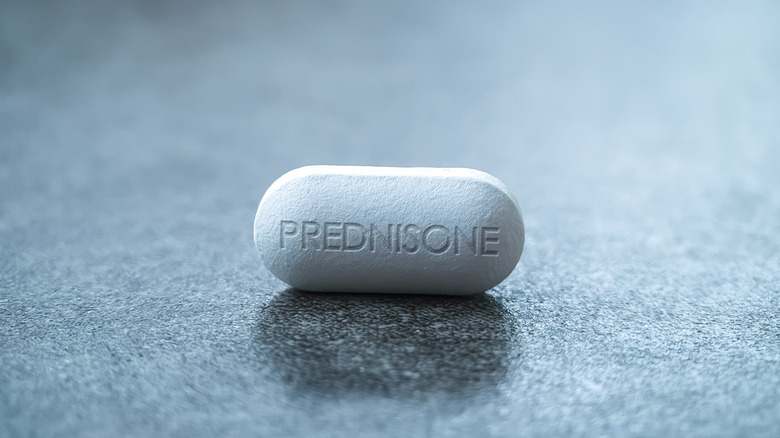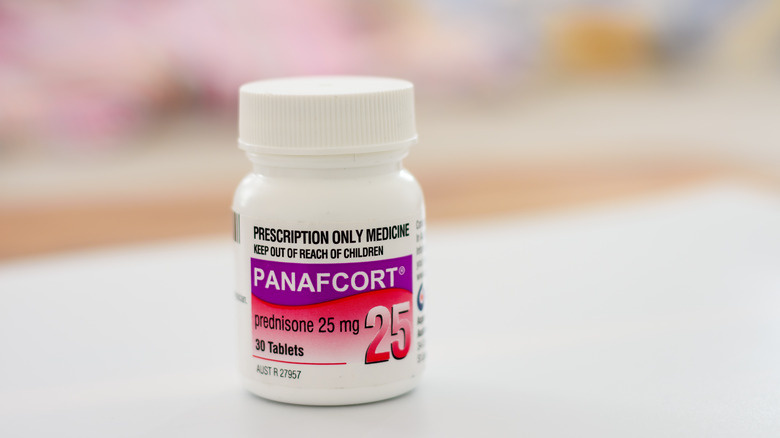Prednisone Explained: Usage, Doses, And Side Effects
Corticosteroids, sometimes referred to as steroids or glucocorticoids, are a class of anti-inflammatory medications used in the treatment and management of almost all parts of medicine (per the NHS). Corticosteroids are very different from anabolic steroids, which are a group of drugs used illicitly by individuals wanting to increase their muscle mass.
Corticosteroids are widely used, but have many adverse effects. For this reason, patients taking these medications require careful monitoring by a healthcare professional (via StatPearls).
Prednisone, one of the most commonly prescribed corticosteroid medications, is used to treat and manage a variety of medical conditions including severe allergic reactions, asthma, inflammatory bowel disease, and arthritis. Here, we'll take a deeper look at the usage, side effects, and dosage of Prednisone so you'll have a better understanding of this anti-inflammatory medication.
Acute and chronic inflammation
In the simplest terms, inflammation can be defined as your body's natural response to protect itself against harmful stimuli, according to Harvard Health. The term inflammation is often divided into two distinct types — acute and chronic.
Acute inflammation, which develops suddenly and lasts for only a brief period of time (usually just a few days) is something just about everyone has experienced at some point in their lives. If you have ever bruised your elbow, cut your finger, or fought off a viral infection, such as the common cold or flu, then you have experienced this type of inflammation. In the case of a cut for example, you might notice that your skin becomes red, swollen, warm, and painful (via StatPearls). These are characteristic signs that acute inflammation is taking place.
During such an acute inflammatory process, the affected cells at the level of your skin release a variety of chemicals (cytokines, acute phase reactants, chemokines, etc.) to promote the activation and recruitment of immune cells to the area "under attack."
Overall, this acute response is largely beneficial. However, in the event that the acute inflammation never fully resolves, chronic inflammation can ensue (per StatPearls). Chronic inflammation may also result from repeat episodes of acute inflammation, long-term exposure to an irritating substance, autoimmunity, or a number of other diseases.
Chronic inflammation results in a number of complex changes to the affected tissues, and depending on the part of the body that's involved, may result in signs and symptoms such as pain, fatigue, weight changes, and even frequent infections.
The role of corticosteroids in reducing inflammation
According to the British Journal of Pharmacology, corticosteroids are a class of medications that can be used to treat inflammation. Corticosteroids work by "switching off" multiple inflammatory genes that may have been activated during an acute or chronic inflammatory response.
Prednisone is perhaps one of the most widely used systemic corticosteroids, according to Allergy, Asthma & Clinical Immunology. It is commonly prescribed as a potent anti-inflammatory and immunosuppressive agent. While not as powerful as some of the other corticosteroids, such as methylprednisolone (Medrol) or dexamethasone (Decadron), prednisone is very useful for the short and long-term management of several inflammatory conditions.
Once taken, prednisone gets processed and activated by the liver into a compound called prednisolone, which then distributes throughout the body via the bloodstream (per StatPearls). In addition to "switching off" several inflammatory pathways, this drug also works by decreasing the number of circulating white blood cells and by stopping the release of pro-inflammatory cytokines.
Corticosteroids are much stronger than Tylenol or Advil
Corticosteroids, such as prednisone, are very different from your typical over-the-counter pain medications. Acetaminophen (Tylenol) for example, works by reducing the production of pro-inflammatory prostaglandins by the brain (per MedicineNet). It's great for quickly reducing a fever and even raising your threshold for pain.
It's also likely that you have heard of non-steroidal anti-inflammatory drugs, known as NSAIDs. These include drugs like ibuprofen (Advil, Motrin), naproxen (Aleve), and ketorolac (Toradol), according to MedicineNet. Similar to corticosteroids, these drugs are also used to quickly reduce inflammation in the body.
However, when compared to the corticosteroids, these medications are much less effective at reducing inflammation. They also have very different indications for their use, side effect profiles, and even contraindications. For these reasons, you will not find drugs like prednisone being sold over-the-counter (per StatPearls). They will instead be prescribed by your healthcare provider as part of a treatment plan.
Prednisone may be used to treat severe allergic reactions
According to the Annals of Emergency Medicine, allergy-related emergency department (ED) visits are very common and account for approximately 1% of all ED visits. Similar to inflammation, allergy stems from "an exaggerated response from the body's immune system to otherwise inert substances present in the environment" (per StatPearls).
Some of the most commonly seen allergies in the ED setting include severe allergic reactions to bee stings, drugs, foods, as well as urticaria, angioedema, and anaphylactic shock (via the European Journal of Emergency Medicine). One of the primary medications used to treat these conditions in the ED setting are corticosteroids, such as prednisone. According to the Annals of Emergency Medicine, anywhere from 51% to 92% of patients coming into an ED for an allergic reaction or anaphylaxis were treated with corticosteroids.
However, new research has begun to question the use of corticosteroids, such as prednisone, in the treatment of severe allergic reactions in the ED. In addition to the risk of serious adverse effects after short-term, high-dose therapy, these researchers are now asking the medical community to reconsider the use of corticosteroids in these settings as their benefit is proving questionable.
It could be used to treat asthma
Asthma is a chronic inflammatory disease affecting the lungs (per WebMD). It affects roughly 25 million Americans and is responsible for about 1.6 million emergency department visits every year.
Asthma is caused by chronic inflammation of the bronchioles, or the tubes that connect the throat to the lungs. People suffering from asthma commonly experience symptoms such as coughing, wheezing, shortness of breath, chest pain, and difficulty sleeping.
Oral corticosteroids, such as prednisone, are a mainstay in the treatment of severe or hard to control asthma, according to Healthline. They may also be prescribed for acute asthma flare-ups (via Asthma and Allergy Foundation of America). Oral corticosteroids have been shown to significantly reduce the number of ED visits and hospitalizations for asthma.
In a review by Canadian Family Physician on the management of acute asthma attacks, researchers found that a short five-day course of oral prednisone was beneficial in the treatment of moderate and severe asthma attacks, as well as mild exacerbations that were unresponsive to other therapies.
Because there are potential harms associated with long term use of prednisone, this medication is usually only prescribed for periods of 5 to 10 days. However, long-term use may be indicated if a patient's asthma is difficult to control (via Healthline).
It may be used to treat inflammatory bowel disease
Inflammatory bowel disease (IBD) is a chronic inflammatory condition of the gastrointestinal tract, and can be divided into Crohn disease and ulcerative colitis (per StatPearls). These conditions are characterized by repeat episodes of inflammation that are triggered by an inappropriate response to the gut microbiome. Some of the more common symptoms include diarrhea, constipation, and abdominal pain.
IBD can result in a number of serious complications if left undiagnosed or if poorly managed. These include strictures, colon perforation, anal fistulas, abscesses, anemia, arthritis, gallstones, gallbladder disease, and may even increase the risk of colon cancer.
Mild to moderate IBD is typically treated with a class of anti-inflammatory drugs called aminosalicylates, such as mesalamine (Delzicol, Rowasa). For patients with moderate to severe IBD, treatment options range from biologics, such as infliximab (Remicade) and adalimumab (Humira), to other immunosuppressant drugs such as azathioprine (Azasan) and methotrexate (Trexall), according to the Mayo Clinic.
When it comes to treating IBD, prednisone is typically reserved for managing acute flare-ups (per Massachusetts General Hospital). Flare ups usually present with a combination of diarrhea, abdominal pain, and rectal bleeding, according to the British Journal of General Practice.
Prednisone for arthritis
According to the Cleveland Clinic, arthritis is defined as a chronic inflammatory disorder affecting the joints. There are several different types of arthritis including osteoarthritis, psoriatic arthritis, gout, and rheumatoid arthritis, among others. While each type of arthritis has its own unique set of symptoms, the more common ones include pain, redness, stiffness, swelling, tenderness, and warmth of the affected joint(s).
When it comes to osteoarthritis, a study in The Lancet found that a six-week course of oral prednisone was safe and effective for the treatment of patients with painful osteoarthritis of the hands, especially in those with flare-ups of their disease.
Psoriatic arthritis is another type of arthritis that can be effectively managed with oral prednisone (via Medical News Today). According to a study published by the British Medical Journal, "The use of systemic corticosteroids at intermediate doses in a slow tapering regimen concomitantly with DMARD [disease modifying anti-rheumatic drug] can be safely used in patients with PsA [psoriatic arthritis]."
Gout is another type of arthritis that is commonly treated with prednisone (per The Journal of Family Practice). A short five-day course of oral prednisone can be used either as a first-line treatment or when NSAIDs are contraindicated.
Low-dose short-term prednisone therapy can also be used to treat rheumatoid arthritis, according to Advances in Rheumatology. This regimen's results have even been shown to induce disease remission in the majority of newly diagnosed patients.
Prednisone may treat sarcoidosis
Sarcoidosis is a multi-system chronic inflammatory disease of unknown cause (per American Family Physician). Signs and symptoms include fatigue, swollen lymph nodes, weight loss, joint pain, persistent dry cough, shortness of breath, wheezing, and chest discomfort (per the Mayo Clinic). Left untreated, sarcoidosis can affect multiple organ systems throughout the body. These include the lungs, skin, eyes, and heart.
While there is no cure for sarcoidosis, oral corticosteroids such as prednisone are usually the first line treatment, according to the Mayo Clinic. In a Cochrane review, treatment of sarcoidosis with oral corticosteroids for six to 24 months resulted in significantly improved symptoms, chest x-ray findings, and spirometry readings. Those most likely to see these improvements were patients in the later stages of the disease. However, it is unclear from the study if oral corticosteroids had any effect on long-term disease progression.
Dosing and formulations
According to the Drugwatch, prednisone comes in a variety of formulations including immediate-release tablets, delayed-release tablets, and oral suspensions.
The standard dosage form of most oral medications is immediate-release (per The Journal of Clinical Psychiatry). These medications, such as prednisone immediate-release tablets, dissolve within minutes of ingestion. Blood levels of the drug will peak and gradually decline as the drug is metabolized and eliminated. Immediate-release prednisone tablets are available in six different milligram strengths: 1, 2.5, 5, 10, 30, and 50 (via Drugwatch).
Delayed-release prednisone tablets are specifically formulated to release the drug over a four-hour period. According to the Rheumatology Network, certain inflammatory conditions produce symptoms at night while patients are sleeping. For example, patients suffering from rheumatoid arthritis commonly wake up with morning stiffness in their joints. In cases like these, delayed-release formulations of prednisone would be a great alternative. Patients could take a bedtime dose which would then take effect at around 3 a.m., the time where it's needed most. Delayed-release prednisone tablets (Rayos) are available in three milligram strengths: 1, 2, and 5, according to Drugwatch.
Finally, prednisone can be prescribed as an oral solution (Prednisone Intensol), which has very specific indications and comes in a 5 milligrams per deciliter concentrate solution (per Kaiser Permanente).
Side effects
Corticosteroids are known by healthcare providers to be a double-edged sword, according to StatPearls. This means that they have the potential to provide significant benefit with a low rate of adverse effects if dosed correctly. However, if given at too high of a dose or for too long, they can result in serious unwanted effects.
The list of side effects caused by prednisone is long and involves just about every organ system in the human body (per Drugwatch). Some of the more common adverse effects include acne, blurred vision, behavior and mood changes, dizziness, elevated blood pressure, high blood glucose, fluid retention causing swelling, headache, increased appetite, insomnia, fatigue, nausea, vomiting, restlessness, sleep problems, thinning of the skin, and weight gain. These effects tend to be mild, and are most commonly seen in patients who are taking low doses over a short period of time.
On the other hand, patients taking larger doses over longer periods of time may develop more serious side effects. Some of these include heart problems, decreased bone mineral density (osteopenia and osteoporosis), eye damage, liver toxicity, risk of gastrointestinal perforation, heightened risk of infection, severe depression, shifting fat distribution, and dermatologic complications.
Prednisone may cause Cushing syndrome
Corticosteroids, including prednisone, exert a strong effect on the hypothalamic-pituitary-adrenal (HPA) axis, explains StatPearls. This axis is made up of a complex system of neuroendocrine hormones which function to keep the body in a state of homeostasis (per Frontiers). In other words, the HPA axis stabilizes and balances the human body so that the organ systems are able to work smoothly and efficiently with one another (via BMJ).
According to the Journal of the Endocrine Society, Cushing syndrome is a rare disease most commonly caused by the use of glucocorticoid medications. Cushing syndrome is a condition that can occur when corticosteroids, such as prednisone, affect the HPA axis.
The signs and symptoms associated with Cushing syndrome are due to an excess of circulating cortisol (per the Mayo Clinic). One of most common symptoms is weight gain and fatty tissue deposition in the areas around the midsection, upper back, face, and between the shoulders. Fatty tissue deposition around the face results in a condition called "moon face," where the face develops a rounded appearance reminiscent of a moon. Fatty tissue deposition around the shoulders results in a characteristic sign known as "buffalo hump."
Other common symptoms of Cushing syndrome include pink-colored stretch marks around the abdomen, thinning of the skin, slow healing of wounds, thicker or more visible body and facial hair (hirsutism), mood changes, and irregular or absent menstrual periods (per the Mayo Clinic).
Cushing syndrome caused by oral corticosteroid medications is treated by stopping or tapering the dose of the drug (via StatPearls). Patients on long-term steroid therapy may take several months for their symptoms to fully resolve.
It may result in immunosuppression
Corticosteroids, including prednisone, have both anti-inflammatory and immunosuppressive effects (via StatPearls). These effects are known to be dose-dependent, meaning that the larger dose someone is on, the more of these effects you will see. Specifically, corticosteroids are known to decrease the number of circulating white blood cells and inhibit the release of pro-inflammatory chemical signaling molecules (i.e, cytokines).
Patients who are on a dose of prednisone less than 10 milligrams per day are not at increased risk for infection. However, patients on a dose higher than 10 milligrams per day have a significantly increased risk (per StatPearls). Infections may be mild as well as life-threatening, depending on the specific organism and location. In particular, patients on high doses of corticosteroids are susceptible to invasive fungal and viral infections.
In an article published in The Journal of Clinical Endocrinology & Metabolism, healthcare providers warned that patients taking oral corticosteroids should be extremely cautious over the course of the COVID-19 pandemic, as they may have increased susceptibility to COVID-19 due to the immunosuppressive effects of corticosteroid medications.
Due to the immunosuppressive effects of corticosteroids, patients are also at risk of suffering from reactivation of latent viral infections. For example, according to the CDC, half of the adults in the United States have previously been infected with cytomegalovirus (CMV). Most of these people show no signs or symptoms upon initial infection. However, the virus usually becomes latent and may reactivate at some later time in a patient's life. Intensive therapeutic suppression of a person's immune function — as can occur with high-dose corticosteroids — may trigger CMV reactivation (per Wiener klinische Wochenschrift).
Certain people should not take Prednisone
There are several contraindications for putting someone on oral corticosteroids such as prednisone (via StatPearls). One important contraindication is in patients who have a history of hypersensitivity reactions to the drug or to any component of the formulation, such as the inactive ingredients.
Another important contraindication is in patients who have recently, or are about to take a "live or live-attenuated" vaccine. The CDC explains that patients who are taking more than 20 milligrams per day of prednisone should avoid live or live-attenuated vaccines.
Additional contraindications for corticosteroid use may include patients with osteoporosis, systemic fungal infection, poorly controlled diabetes, joint infections, uncontrolled high blood pressure, infection with varicella (the virus that causes chicken pox), peptic ulcer disease, and heart failure (per StatPearls).














